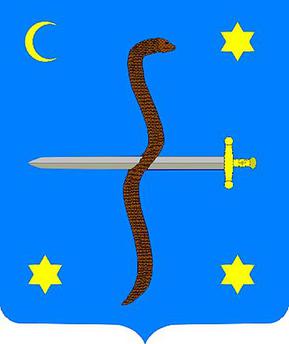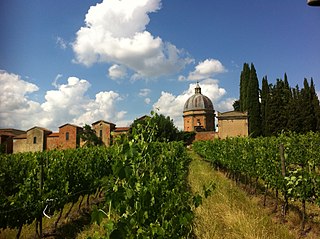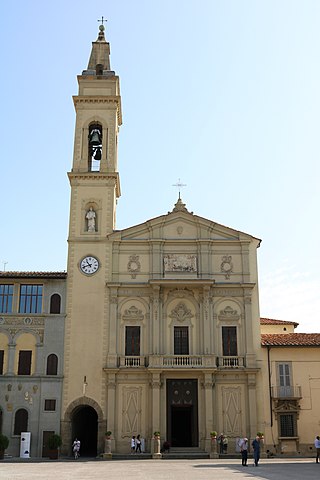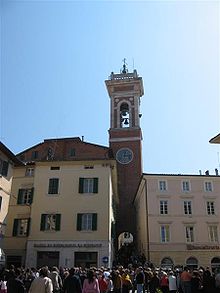
Arezzo is a city and comune in Italy and the capital of the province of the same name located in Tuscany. Arezzo is about 80 kilometres southeast of Florence at an elevation of 296 metres (971 ft) above sea level. As of 2022, the population was about 97,000.

Giorgio Vasari was an Italian Renaissance painter and architect, who is best known for his work Lives of the Most Excellent Painters, Sculptors, and Architects, considered the ideological foundation of all art-historical writing, and still much cited in modern biographies of the many Italian Renaissance artists he covers, including Leonardo da Vinci and Michelangelo, although he is now regarded as including many factual errors, especially when covering artists from before he was born.

Luca Signorelli was an Italian Renaissance painter from Cortona, in Tuscany, who was noted in particular for his ability as a draftsman and his use of foreshortening. His massive frescos of the Last Judgment (1499–1503) in Orvieto Cathedral are considered his masterpiece.

Cortona is a town and comune in the province of Arezzo, in Tuscany, Italy. It is the main cultural and artistic centre of the Val di Chiana after Arezzo.

Città di Castello ; "Castle Town") is a city and comune in the province of Perugia, in the northern part of Umbria. It is situated on a slope of the Apennines, on the flood plain along the upper part of the river Tiber. The city is 56 km (35 mi) north of Perugia and 104 km (65 mi) south of Cesena on the motorway SS 3 bis. It is connected by the SS 73 with Arezzo and the A1 highway, situated 38 km (23 mi) west. The comune of Città di Castello has an exclave named Monte Ruperto within Marche.

Fucecchio is a town and comune (municipality) of the Metropolitan City of Florence in the Italian region of Tuscany. The main economical resources of the city are the leather industries, shoes industry and other manufacturing activities, although in the recent years their number has been decreasing because of a slight recession started.

The Palazzo Vecchio is the town hall of Florence, Italy. It overlooks the Piazza della Signoria, which holds a copy of Michelangelo's David statue, and the gallery of statues in the adjacent Loggia dei Lanzi.

The Bargello, also known as the Palazzo del Bargello or Palazzo del Popolo, is a former barracks and prison in Florence, Italy. Since 1865, it has housed the Museo Nazionale del Bargello, a national art museum.

Bibbiena is a town and comune in the province of Arezzo, Tuscany (Italy), the largest town in the valley of Casentino. It is located 60 kilometres (37 mi) from Florence, 30 kilometres (19 mi) from Arezzo, 60 kilometres (37 mi) from Siena, and 20 kilometres (12 mi) from the Sanctuary of La Verna. There are approximately 11,833 inhabitants

Piazza della Signoria is a w-shaped square in front of the Palazzo Vecchio in Florence, Italy. It was named after the Palazzo della Signoria, also called Palazzo Vecchio. It is the main point of the origin and history of the Florentine Republic and still maintains its reputation as the political focus of the city. It is the meeting place of Florentines as well as the numerous tourists, located near Palazzo Vecchio and Piazza del Duomo and gateway to Uffizi Gallery.

Montevarchi is a town and comune in the province of Arezzo, Tuscany, Italy.

Lucignano is a comune (municipality) in the Province of Arezzo in the Italian region Tuscany, located about 70 kilometres (43 mi) southeast of Florence and about 25 kilometres (16 mi) southwest of Arezzo.

Marciano della Chiana is a comune (municipality) in the Province of Arezzo in the Italian region Tuscany, located about 70 kilometres (43 mi) southeast of Florence and about 20 kilometres (12 mi) southwest of Arezzo.

Santa Trinita is a Roman Catholic church located in front of the piazza of the same name, traversed by Via de' Tornabuoni, in central Florence, Tuscany, Italy. It is the mother church of the Vallumbrosan Order of Monks, founded in 1092 by a Florentine nobleman. South on Via de' Tornabuoni is the Ponte Santa Trinita over the river Arno; across the street is the Palazzo Spini Feroni.
The decade of the 1460s in art involved some significant events.

The Vegni are an Italian family from Siena. The medieval origins of the family have limited documentation. The origin of the family is in Siena, with Bencivenne, father of Aringhieri, whose children Guido, Iacobina and Ranieri are mentioned in a contract of a house sale in 1201. The son of Guido, Bencivenni, is the first one to have a recognised profession mentioned in the documents. A notary of the royal chamber, called Bencivennis olim Guidi, was active in Siena in the first part of the 13th century. The patronymic Bencivennis is used, abbreviated as bcVennis in the documents signed by Luca, a notary, in documents he drew up during late 13th. Pietro olim (of) Luca bcVennis was active in Siena until 1321. The sons of Pietro settled in the area of Chianciano, focusing the centre of interests of the family in the South of the Siena Republic until the fall of it in 1555. The surname Bencivennis remains in official documents during all the Republican period, to disappear at the end of the 16th century, substituted by Vegni. The last one to use it in official documents is Eustachio Bencivennis or bcVegnis, again a notary, who died in 1585. His grandson Giovanni Battista di Pietro, a notary in Chianciano between 1600 and 1641, signs his documents as Vegni, although he still uses the same private legal seal with the family coat of arms.

The Val di Chiana, Valdichiana, or Chiana Valley, formerly Clanis Valley, is a tectonic valley of central Italy, whose valley floor consists of important alluvial residues filled up since the 11th century, lying on the territories of the provinces of Arezzo and Siena in Tuscany and the provinces of Perugia and Terni in Umbria.

Santi Buglioni, by the name of Santi di Michele was an important Renaissance Italian sculptor, the nephew and collaborator of Benedetto Buglioni.

The Temple of Santo Stefano della Vittoria is a small chapel-church located in Pozzo della Chiana, a small hamlet near Foiano della Chiana in the province of Arezzo. The octagonal domed structure looms over the plain of Scannagallo, and was commissioned by Cosimo I de' Medici to commemorate his victory in 1554 over the forces of Siena.

The Insigne Collegiata di San Lorenzo is a church in Piazza Varchi of central Montevarchi, Province of Arezzo, Tuscany, central Italy. Attached to the church is a small museum of sacred art, which includes a reconstructed chapel (tempietto) bedecked with panels by Andrea della Robbia.
























